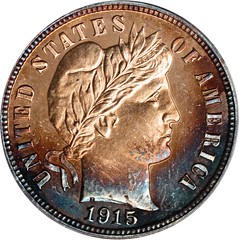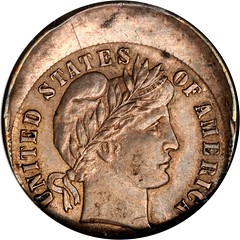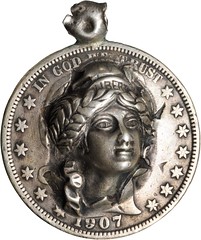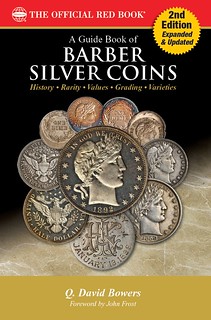
PREV ARTICLE
NEXT ARTICLE
FULL ISSUE
PREV FULL ISSUE
GUIDE BOOK OF BARBER SILVER COINS RECOLLECTIONSDennis Tucker of Whitman Publishing submitted these recollections on the creation of the Guide Book of Barber Silver Coins. Thanks. -Editor
Today the group has members nationwide and is very active. Barber-related courses are taught at the ANA Summer Seminar in Colorado Springs, research is ongoing and robust, and the BCCS hosts meetings at regional coin shows, stages exhibits, and sponsors educational programs throughout the year. The Journal features a growing variety of articles and full-color "Featured Collections." "We believe in education as one of the BCCS's key missions," says Frost. "Many newer collectors get their first real overviews of Barber coinage at one of our programs." Along with the birth of the Barber Coin Collectors' Society, by the late 1980s the coins had attracted the attention of researchers who shared their knowledge in books and articles. Q. David Bowers, by then well established as a leading coin dealer and numismatic scholar, had studied the silver Barber series for many years. In 1986 he published United States Dimes, Quarters, and Half Dollars: An Action Guide for the Collector and Investor. He wrote "Barbers, a Unique Perspective to Their History, Beauty, and Rarity" in 1989, the first year of the Journal of the Barber Coin Collectors' Society. David Feigenbaum, writing as David Lawrence, published the Complete Guide to Barber Quarters in 1989 and 1994, and similar guides to Barber dimes (1991) and half dollars (1992). (These all went out of print but were made publicly available, online, about 20 years after publication.) Throughout the 1990s and continuing to the present, the Cherrypickers' Guide to Rare Die Varieties, by J.T. Stanton and Bill Fivaz, has featured coverage of doubled dies, repunched mintmarks, and other collectible variations in every U.S. coin series including the silver Barbers. Other Barber-specific books followed. The Complete Guide to Certified Barber Coinage, by David and John Feigenbaum, a 146-page reference published in 2000, gave "information essential for purchasing Barber coinage, including history, rarity ratings, and date and mintmark analysis." Other self-published books on Barber dimes, quarters, and half dollars emerged in the early 2000s, showcasing many previously unpublished die varieties. In 2009 Jeff Ambio's Collecting and Investing Strategies for Barber Dimes, a 432-page guide, shared detailed analyses of Proof and circulation-strike Barber dimes and their market performance, and advice on collecting. Meanwhile, other research and analysis continued, and more and more Barber articles were published in Coin World, Numismatic News, The Numismatist, and similar hobby periodicals. The coins of Charles Barber were highlighted among the 100 Greatest U.S. Coins (by Jeff Garrett and Ron Guth, first edition 2003), studied in the Guide Book of United States Type Coins (by Bowers, first edition 2005), and covered annually in the Guide Book of United States Coins (the hobby's popular "Red Book"). Against this backdrop, in June 2014 I asked Dave Bowers what he thought of adding A Guide Book of Barber Silver Coins to Whitman's Bowers Series lineup. We had already studied Charles Barber's copper-nickel five-cent pieces in volume 5 (the Guide Book of Liberty Head and Buffalo Nickels, 2006). And we had the successors to the Barber dime, quarter, and half dollar slated for publication in the Guide Book of Mercury Dimes, Standing Liberty Quarters, and Liberty Walking Half Dollars, which would become volume 18 in the Bowers Series, published in July 2015. The time seemed ripe to focus an entire Whitman book on the chief engraver's most famous coins.   Dave jumped into the Barber coin project with his usual gusto, tapping into his extensive research archives and marshaling specialists around the country, including many members of the Barber Coin Collectors' Society. A solid year of work went into the effort. On August 12, 2015, at the American Numismatic Association World's Fair of Money in Chicago, Dave and I spoke at the annual meeting of the BCCS. Everyone was excited for the new book's debut. It came out a month later, in September 2015. The Guide Book of Barber Silver Coins inspired Kenneth Bressett, then senior editor (and now editor emeritus) of the Guide Book of United States Coins, to fondly recall his early days of collecting in the 1940s. "There is no going back to those halcyon days of finding Barber coins in circulation," he wrote in the foreword to the first edition. "Today there is a new era of interest in these classic items, and one with new attitudes about the value and desirability of mintmarks, condition, and varieties. It is also a time when these coins can be more fully appreciated for their place in our nation's numismatic history." He praised the new book as "a fresh landmark account of Barber coinage touching on every aspect of availability, condition, varieties, history, and collectability of these fascinating coins." The hobby appears to share Ken Bressett's appreciation. Collectors bought thousands of copies of the first edition of the Guide Book of Barber Silver Coins. Now, a few years later, we have the second edition. What does the numismatic community look like today for Barber coin collectors? Many active hobbyists focus on Fine, Very Fine, and Extremely Fine grades. This makes a full set of the three denominations, minus the 1894-S dime, an affordable quest for many BCCS members. A number of collectors are also building AU-55 to -58 sets. Most surviving coins are in About Good or Good-also widely collected, and even more affordable. Although the vast majority of Barber coins are found in low circulated grades, the series also have their adherents among registry-set collectors. These are specialists who compete to build sets of the finest-graded coins they can assemble, ranked against others in competitions coordinated by the major third-party grading firms. In the spring of 2019, PCGS has 184 registered "major" sets and 10 registered "specialty" sets of Barber dimes; 133 major sets and 8 specialty sets of Barber quarters; and 191 major and 12 specialty sets of Barber half dollars. In the NGC Collectors Society Registry, there are 176 competitive Barber dime sets in total; 149 Barber quarter sets; and 125 Barber half dollar sets.   In an informal poll of 127 hobbyists in the spring of 2018, I found that 17 percent consider themselves active or very active collectors of Barber silver coins (constantly upgrading their sets, collecting die varieties by Fivaz-Stanton number, filling albums and folders, and/or active in the BCCS); 21 percent consider themselves casual collectors (collecting the coins but not as their primary interest); 37 percent own some of the coins but don't consider themselves collectors (with more of an accumulation than a collection); and 25 percent don't collect or own them at all. Comments from those polled include: • "I'm working on a VG set of quarters and halves. They're mostly the first thing I'm looking for, walking into a coin show. One day I'll work on the dimes." • "I had accumulations of all three denominations once upon a time, focusing on the better dates in Fine to AU. Sold off the halves, then the dimes. Still have the hoard of quarters." • "I've taken a break recently, but when I'm active it's a sickness." • "I like them as junk silver. I'd rather have circulated Barber stuff than Washington quarters or Roosevelt dimes." • "They are attractive in Mint State." • "Barber dimes mostly, slowly participating in the registry. I only buy a few pieces a year, no rush, just nice pieces when they come available." • "My halves set is complete and I have done a little upgrading on some of the lower-quality ones. I have always favored the quarters for some odd reason and have been continually looking out for upgrades to my set." • "Original, attractive circulated Barbers do grab my attention when I see them." • "Always been fascinated with them, but the higher-quality issues are expensive. I like them in G/VG bulk rolls I can pour out of the tube, like treasure. I do occasionally buy/sell some nice higher-grade PCGS circs, mainly halves." • "I prefer Mint State, and think there is more value there." • "I generally prefer circs to MS Barbers, as I appreciate the 'workhorse' aspect of the coins more than the design." And one very active collector, trying to steer competitors away from "the good stuff," facetiously warned: "Barber material is hideous. Terrible design . . . mundane. Avoid at all costs, especially examples in the VF-EF range." Research and fellowship continue in the field. Collectors study die states, share photographs of their coins, and keep in touch online and in person. Specialists scrutinize die varieties, and seek out errors and misstrikes, pattern pieces, love tokens engraved on Barber coins, and other byways of the series. This is not a moribund area of numismatics. Researchers such as John Frost continue to unearth fascinating unpublished history. His Charles Barber-related appendix in the new second edition of the Guide Book of Barber Silver Coins marks this research's first publication in book form. Reading the latest research, hearing feedback from collectors, and surveying the lay of the hobby tells me that Barber silver coins are well known and appreciated. They have a relatively small fan base (compared to, for example, Morgan dollars)-but those fans are very enthusiastic. At the same time, there's still room at the table for newcomers to join the ranks, for casual collectors to become more active, and for everyone to contribute to ongoing research and education. There's much that's new in the second edition of the Guide Book of Barber Silver Coins. There will be even more, when the time comes, in the third.   Dennis Tucker is the publisher of Whitman Publishing, LLC; numismatic specialist on the Treasury Department's Citizens Coinage Advisory Committee; and author of American Gold and Silver: U.S. Mint Collector and Investor Coins and Medals, Bicentennial to Date. A Guide Book of Barber Silver Coins, 2nd edition

Wayne Homren, Editor The Numismatic Bibliomania Society is a non-profit organization promoting numismatic literature. See our web site at coinbooks.org. To submit items for publication in The E-Sylum, write to the Editor at this address: whomren@gmail.com To subscribe go to: https://my.binhost.com/lists/listinfo/esylum All Rights Reserved. NBS Home Page Contact the NBS webmaster 
|
